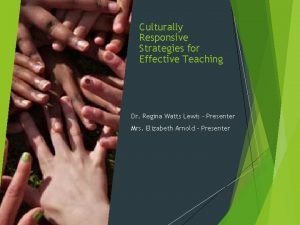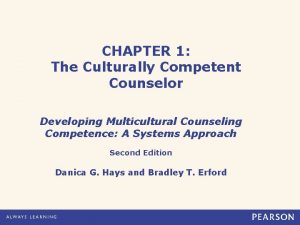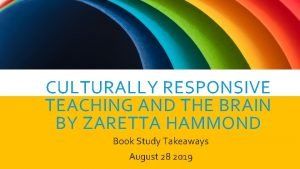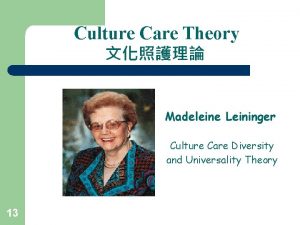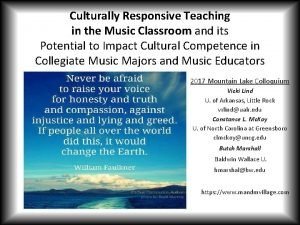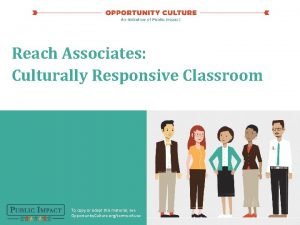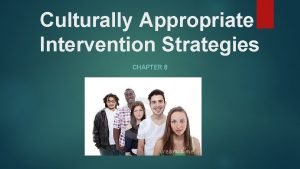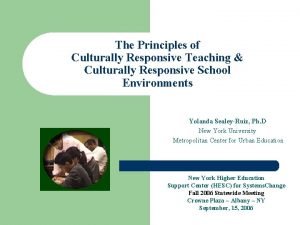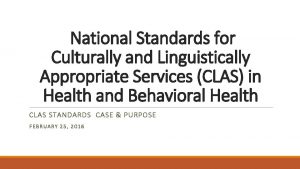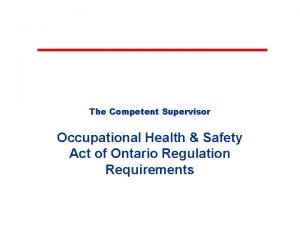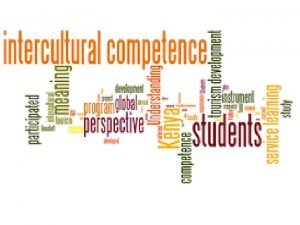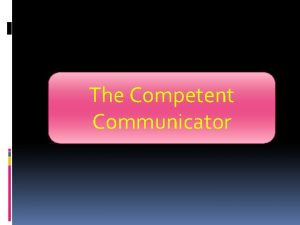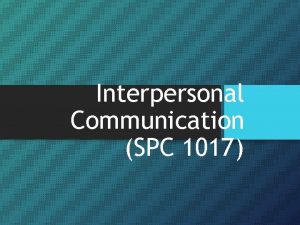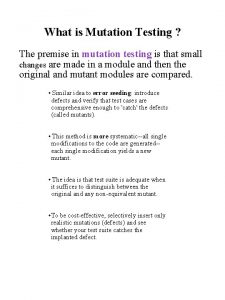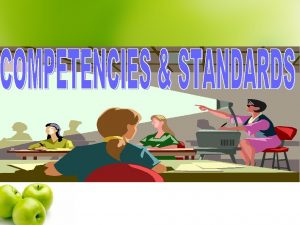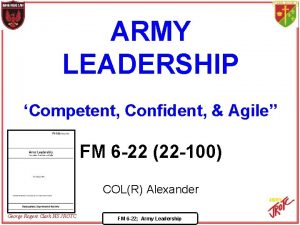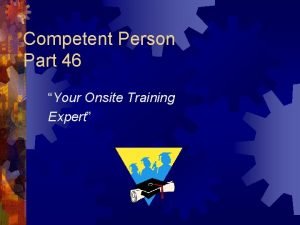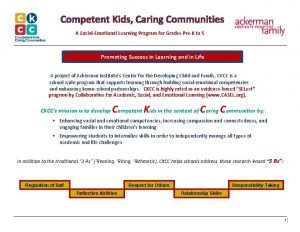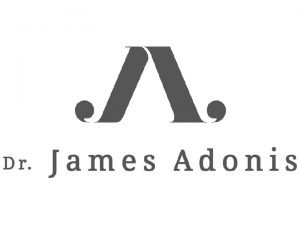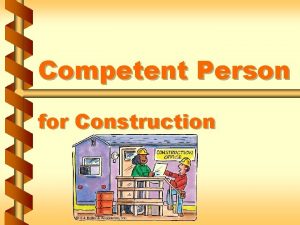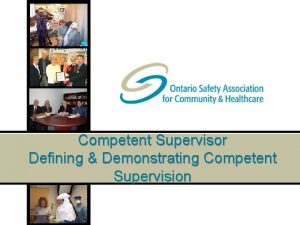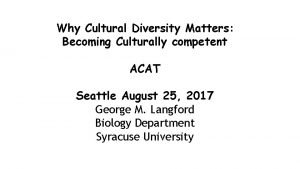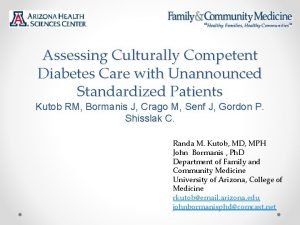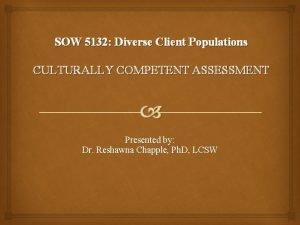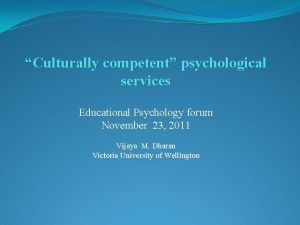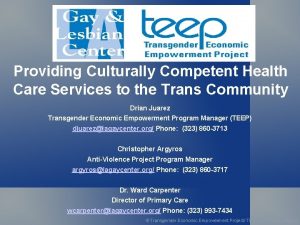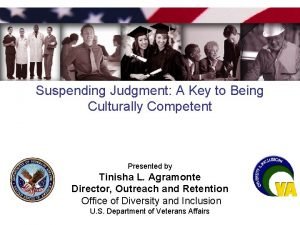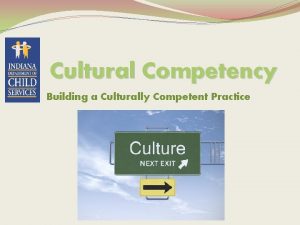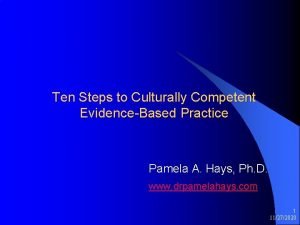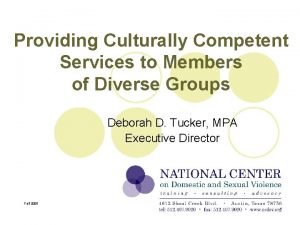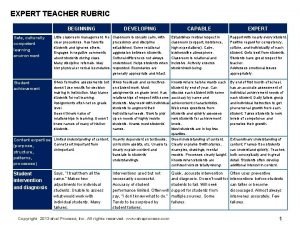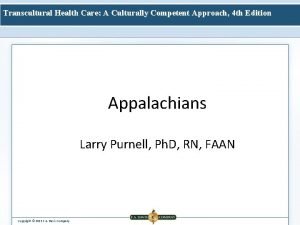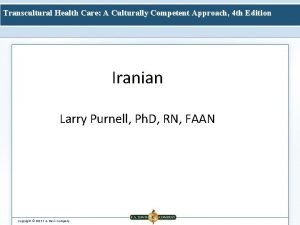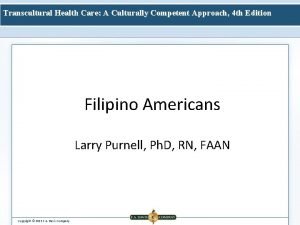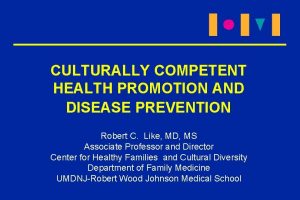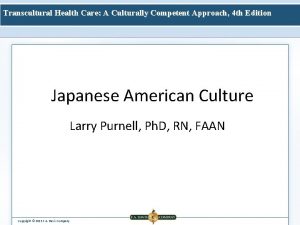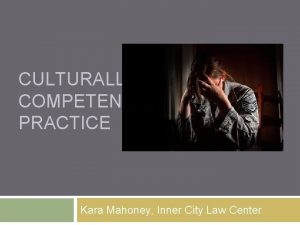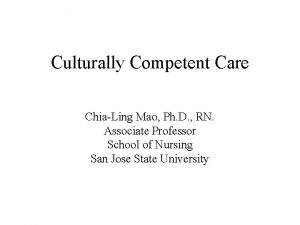How to teach for a culturally competent world

































- Slides: 33

How to teach for a culturally competent world PAMELA H. MITCHELL 4 TH ANNUAL CULTURAL COMPETENCE CONFERENCE, MARCH 27, 2015 TEXAS TECH UNIVERSITY

Objectives Explore the many cultures involved in interprofessional teaching and practice Identify one’s own experiences with cultural stereotyping in teaching and learning Evaluate multiple approaches to inclusivity in interprofessional teaching

The many cultures involved in interprofessional teaching and practice Cultural awareness Gender Race Ethnicity Geographic Sociopolitical Professional and interprofessional culture

Cultural Competence: Definition and Conceptual Framework Cultural competence requires that organizations: have a defined set of values and principles, and demonstrate behaviors, attitudes, policies and structures that enable them to work effectively cross-culturally. have the capacity to (1) value diversity, (2) conduct self-assessment, (3) manage the dynamics of difference, (4) acquire and institutionalize cultural knowledge and (5) adapt to diversity and the cultural contexts of the communities they serve. incorporate the above in all aspects of policy making, administration, practice, service delivery and involve systematically consumers, key stakeholders and communities. Cultural competence is a developmental process that evolves over an extended period. Both individuals and organizations are at various levels of awareness, knowledge and skills along the cultural competence continuum. (adapted from Cross et al. , 1989) http: //nccc. georgetown. edu/foundations/frameworks. html#ccdefinition.

Definitions - ”The idea of more effective cross-cultural capabilities is captured in many terms similar to cultural competence. Cultural knowledge, cultural awareness, and cultural sensitivity all convey the idea of improving cross-cultural capacity, as illustrated in the following definitions: Cultural Knowledge: Familiarization with selected cultural characteristics, history, values, belief systems, and behaviors of the members of another ethnic group (Adams, 1995). Cultural Awareness: developing sensitivity and understanding of another ethnic group. This usually involves internal changes in terms of attitudes and values. Awareness and sensitivity also refer to the qualities of openness and flexibility that people develop in relation to others. Cultural awareness must be supplemented with cultural knowledge(Adams, 1995). Cultural Sensitivity: Knowing that cultural differences as well as similarities exist, without assigning values, i. e. , better or worse, right or wrong, to those cultural differences (National Maternal and Child Health Center on Cultural Competency, 1997)” http: //cecp. air. org/cultural/Q_howdifferent. htm, retrieved March 7, 2015 Center for effective collaboration and practice

Cultural awareness Acknowledge cultural differences and be aware of how these impact care. Recognize how one’s own culture impacts one’s thoughts and actions. Understand cultural differences at the practice level, when patients and providers bring unique histories. Make a conscious effort to understand the meaning of the other’s behavior within the context of his or her culture. Health care providers should gain information as they can, but comprehensive knowledge is not attainable. Providers should how obtain information needed in the moment to reach a patient care goal. (Cross et al. , 1989, pp. 32 -35)

Cultural safety “Cultural safety aims to improve the health status and wellbeing of New Zealanders and applies to all relationships through: 1) an emphasis on health gains and positive health and wellbeing outcomes; 2) acknowledging the beliefs and practices of those who differ from them. For example, this may be by: age or generation, gender, sexual orientation, occupation and socio-economic status, ethnic origin or migrant experience, religious or spiritual belief, disability” Arose from concerns of Maori students and families about lack of understqnding of their culture by non-Maori providers of health care http: //en. wikipedia. org/wiki/Cultural_safety, retrieved March 7, 2015

Core competencies for interprofessional collaborative practice Values & Ethics (VE 3). Embrace cultural diversity and individual differences characterizing patients, populations, and health care teams. Values and Ethics (VE 4). Respect the unique cultures, values, roles/responsibilities, and expertise of other health professions. (Interprofessional Education Collaborative Expert Panel, 2011, p. 19).

UW School of Nursing Principles of Inclusion We affirm the inherent dignity of each individual and group. We affirm that group differences are socially, culturally, and historically constructed and hierarchically arranged, resulting in the inequitable distribution of resources among groups. This construction and distribution can be changed and we commit to change it. We affirm our commitment to address difference, privilege and power at the School of Nursing. We will address privilege and power using anti-racist and anti-oppression principles of on-going education, open dialogue, skill building, challenging the status quo, and accountability to people of color and other social groups. We affirm our commitment to increase the numbers of faculty, students and staff from underrepresented groups, and to support their leadership within the school. We affirm our commitment to work toward a climate of inclusiveness on all levels of the School of Nursing. http: //nursing. uw. edu/about/diversity

Core principles UW School of medicine After participating in and completing their medical education and training offered by the University of Washington School of Medicine, every medical student should be able to: Become aware of his/her own assumptions about human behavior, values, biases, preconceived notions, and personal limitations that may impact his/her clinical decision making and care of his/her patients. Understand the world view of culturally diverse populations (values, assumptions, practices, communication styles, group norms, biases, experiences, perspectives, etc. of culturally diverse faculty, colleagues, staff, patients and her/his families, and the communities they are from). Develop and practice appropriate, relevant and sensitive strategies and skills in working with culturally diverse populations. Understand that the process in becoming cultural proficient is a continuum. Advocate on behalf of the needs of the diverse populations they work with.

The culturally competent …. Student Is one who has moved toward being culturally aware, and is sensitive to his/her own cultural heritage and to valuing and respecting differences. a. The student has begun the process of exploring his/her own values, standards and assumptions about human behavior and quality of life. b. Rather than being ethnocentric and believing in the superiority of his/her group’s cultural heritage (customs, traditions, language, ability, religion or spirituality, quality of life), there is acceptance and respect for cultural differences and multiple identities. c. The student understands that individual and group (social) identities are a product of where we are in our personal development and in what context, capacity and environment in which we are engaged. From: Core Guiding Principles for Cultural Competence for Medical Education David Acosta, MD, Amen Tsegai, MA, Victoria Gardner, Ed. D, Pam Racansky, MA Version 2. 0, March 31, 2011 http: //depts. washington. edu/cedi/new/PDF/Core. Guiding. Principles. pdf, last retrieved March 10, 2015

Health care team as a culture Ø “team” creates a new culture with group norms for values and behavior. Ø The cultural values: Ø shared goals, Ø clear roles, Ø mutual trust, Ø effective communication, and Ø measurable processes and outcomes Ø full inclusion of patients as team members

Multiple approaches to inclusivity Some resources Some experiential exercises in context Cultural competence training should encompass interactions with the patient in the context of the team, rather than individual interactions as is often the focus. Such training could begin in a simulated setting with a standardized patient, but could also be accomplished in student experiences in the clinical setting in learning activities with objectives clearly focused on cultural competence. (from Buchanan et al, http: //collaborate. uw. edu/blogs/main-blog/teaching-cultural-competence-forthe-health-care-team. html) IPE exercises

Learning about difference The study of diversity fosters understanding of cultural traditions, histories, and influences; sharpens critical and analytic thinking; explores sources of inequality in society; and encourages a vibrant intellectual community free of bias and prejudice. http: //www. washington. edu/diversity/learning-aboutdifference/

Resources http: //nccc. georgetown. edu/foundations/frameworks. html#ccdefinition.

http: //collaborate. uw. edu/

Your own cultural identity What cultural identities do you have? I am a woman A nurse and academic leader The daughter of people who came of age in the Great Depression The granddaughter of immigrants The wife of a retired physician The mother of 3 accomplished sons And grandmother to 3 adorable children Hans Jacob Holtzklau came to America in 1714 He was our American immigrant ancestor. Jacob changed the spelling of our name by signing his will Jacob Holtzclaw. 14 individuals with families totaling 42 persons from the town of Siegen and Muesen in the principality of Nassau-Siegen, Germany to come to Virginia. The First Germanna Colony arrived in Virginia at Tappahannock in the spring of 1714, and then came up the Rappahannock River where they settled 20 miles west of Fredericksburg at a location that would be called Fort Germanna.

UW Center for Health Sciences Interprofessional Education…. http: //collaborate. uw. edu/educators-toolkit/faculty-development-training-toolkit/ipe-faculty-development-learning-activity-int

Identify own experience in cultural stereotyping Let’s play interprofessional pictionary

Role Clarity and Responsibility Stereotyping and Biases • Stereotyping related to professional roles, demographic & cultural differences affect the health professions • Stereotypes help create ideas about a profession’s worth known as “disparity diversity” (Edmondson & Roloff, 2009), eroding mutual respect. • Inaccurate perceptions about diversity prevent professions from taking advantage of the full scope of abilities that working together offers to improve health care.

Roles Across Professions • • Expert Communicator Educator Advocate Professional Collaborator Manager Leader Medicine Nursing Pharmacy Physical Therapy Dentistry Social Work Public Health Physician Assistant

“We may look in the same direction, even at the ‘same lines’, and not see what our colleagues sees. ” (Mc. Kee, 2003)

Interprofessional Pictionary • As a team, decide who the health care professional is based on information provided • Draw a representation of the health care professional without using letters or numbers • Be prepared to share how everyone has contributed to the drawing • After each team finishes drawing, the other teams should guess the profession prior to discussion

IP Pictionary: Reflection What assumptions am I making? Where did I learn these values? What values/beliefs orient me? How might someone whose role is different than mine look at this? • Why do I feel threatened when I am challenged on this? • • (Mc. Kee, 2003)

Interprofessional Pictionary • Acknowledgements: IP Pictionary Game developed by Debbie Kwan at the Educating Health Professionals for Interprofessional Care, University of Toronto (Ehpic 2011 Certificate Course) http: //www. ipe. utoronto. ca/ Edited and revised as Faculty Development Toolkit to teach IPE Competency Domain: role clarity by the University of Washington Macy Grant Team Core competencies for interprofessional collaborative practice (IPEC, 2011)

Interprofessional Pictionary – Represent this professional Ø Ø Ø Team up with 3 or 4 people from different professions: decide who the health care professional is based on information provided in the box on the right Draw a representation of the health care professional without using letters or numbers Training Requirements: Doctoral Degree Usual Practice settings: Hospitals (inpatient and outpatient care), Community Settings, Clinics Scope of Practice includes: Health and medication education, treatment consultation, prescribe under protocol, administer medications, provide immunizations Unusual Practice setting: NASA Be prepared to share how everyone has contributed to the drawing

More Resources http: //ethnomed. org/

http: //ethnomed. org/culture

Web Resources http: //odt. uwmc. washington. edu/pdfs/Respect. Through. Understanding. pdf - slide set http: //depts. washington. edu/ethnomed/HMCproject/hmcproject_talk_0302/F_Ethn o. Med%20 Home%20 Page. htm http: //ethnomed. org/ethnomed/about/

IPE Faculty Development Training Learning Activity: Barnga is a simulation game that helps players address challenges they may face when interacting with a different profession’s culture. Each group of players receives a slightly different set of instructions for a card game (ace is the weakest or strongest, spades are the trumps cards or there is no trump card, etc. ) The winner and loser of each group will then rotate to play with another group; the players are not told that the rules of the game are different in this new “culture” and will be forced to resolve communication problems with people who do not share their understanding of the rules. Developed by: Educational psychologist Sivasailam “Thiagi” Thiagarajan, Ph. D. Total time needed for the activity is 90 minutes. Barnga covers IPE competencies in all four domains. Materials needed: Some pencils and blank sheets of paper. A bell. A deck of cards for each table. Each deck must be modified so that it includes only the following cards: Cards 2 -7 in each suit as well as all four aces. The instructions to play “Five Tricks” (Appendix 1, all ten versions of the game). A copy of the “Discussion Guidesheet” (Appendix 3) for the facilitator. http: //collaborate. uw. edu/educators-toolkit/faculty-development-training-toolkit/ipefaculty-development-training-learning-a-1

Your preferred teaching tools What approaches have you found helpful? What aspect of cultural competence are these aimed at?

References Acosta, D, Tsegai, A, Gardner, V, Racansky, P (2011) Core guiding principles for cultural competence for medical education. University of Washington School of Medicine http: //depts. washington. edu/cedi/new/PDF/Core. Guiding. Principles. pdf, last retrieved March 10, 2015 Buchanan, DT (3014) Teaching Cultural Competence for the Health Care Team. Center for Health Sciences Interprofessional Educational blog, Updated on July 16 th, 2014 at 2: 12 pm, http: //collaborate. uw. edu/blogs/mainblog/teaching-cultural-competence-for-the-health-care-team. html, last retrieved March 7, 2015 Cross, T. L. , Bazron, B. J. , Dennis, K. W. , Isaacs, M. R. (1989). Towards a culturally competent system of care: A monograph on effective services for minority children who are severely emotionally disturbed. Washington, D. C. : National Institute of Mental Health, Child and Adolescent Service System Program. Interprofessional Education Collaborative Expert Panel. (2011) Core competencies for interprofessional collaborative practice: Report of an expert panel. Washington, D. C. : Interprofessional Education Collaborative. https: //ipecollaborative. org/uploads/IPEC-Core-Competencies. pdf, last retrieved March 10, 2015 Mitchell, P. , Hall, L. , & Gaines, M. (2012). A social compact for advancing team-based high-value health care. Health Affairs Blog. Retrieved from http: //healthaffairs. org/blog/2012/05/04/a-social-compact-for-advancing-team-based-high-value -health-care/

References Mitchell, P. , Hall, L. , & Gaines, M. (2012). A social compact for advancing team-based high-value health care. Health Affairs Blog. Retrieved from http: //healthaffairs. org/blog/2012/05/04/a-social-compact-for-advancing-team-based-high-value -health-care/ Last retrieved March 10, 2015 Mitchell, P. , Wynia, M. , Golden, R. , Mc. Nellis, B. , Okun, S. , Webb, E. , … Von Kohorn, I. (2012). Core principles & values of effective team-based health care. Washington, D. C. : Institute of Medicine. (http: //iom. edu/Home/Global/Perspectives/2012/Team. Based. Care. aspx, last retrieved March 10, 2015) National Center for Cultural Competence. (nd). Conceptual frameworks/models, guiding values and principles. Retrieved from http: //nccc. georgetown. edu/foundations/frameworks. html#ccdefinition. Last retrieved March 10, 2015 Okun, S, Schoenbaum, SC, Andrews, D, Chidambaran, P, Chollette, V et al (2014). Patients and health care teams forging effective partnerships. Washington DC: Institute of Medicine discussion paper, )http: //iom. edu/Global/Perspectives/2014/Patientsas. Partners. aspx), last retrieved March 10, 2015
 Culturally responsive vs culturally relevant
Culturally responsive vs culturally relevant Culturally competent counselor
Culturally competent counselor Definition of cultural deprivation
Definition of cultural deprivation Vdoe culturally responsive teaching
Vdoe culturally responsive teaching Culturally responsive teaching and the brain book study
Culturally responsive teaching and the brain book study Certified transcultural nurse
Certified transcultural nurse Theory of culture care diversity and universality
Theory of culture care diversity and universality Culturally responsive teaching in music education
Culturally responsive teaching in music education Classroom
Classroom Reach associates
Reach associates Culturally appropriate intervention strategies
Culturally appropriate intervention strategies Working with culturally and linguistically diverse families
Working with culturally and linguistically diverse families Pedagogy meaning
Pedagogy meaning National culturally and linguistically appropriate services
National culturally and linguistically appropriate services Vacant word formation
Vacant word formation Competent supervisor
Competent supervisor Competent person's reporting
Competent person's reporting Cimah
Cimah Interculturally competent
Interculturally competent What makes a competent communicator
What makes a competent communicator Competent authority
Competent authority Spc 1017
Spc 1017 Competent authority
Competent authority Similiarities synonym
Similiarities synonym What is mutation
What is mutation Listening competence
Listening competence Who trains employees that work on scaffolds
Who trains employees that work on scaffolds Fm 6-22 army leadership
Fm 6-22 army leadership Personal humility
Personal humility Competent intercultural communicators resist ambiguity.
Competent intercultural communicators resist ambiguity. Havisten competent
Havisten competent Define competent person
Define competent person Competent kids, caring communities
Competent kids, caring communities Lovable fool
Lovable fool
